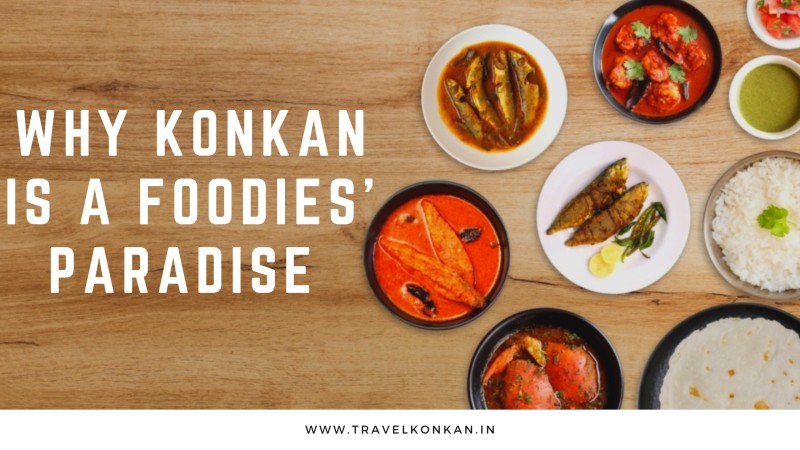🏝️ Introduction: More Than Just Seafood
The Konkan region of Maharashtra — stretching along the western coastline from Palghar to Goa — is often known for its rich seafood and Malvani-style curries. But for vegetarians, the region holds a lesser-known treasure: a deeply rooted tradition of flavorful, wholesome vegetarian cuisine.
From the coastal villages of Ratnagiri to the lush ghats of Amboli, vegetarian Konkani food reflects seasonality, simplicity, and strong cultural ties to the land.
In this blog, we’ll explore:
- Traditional vegetarian dishes in Konkan
- Local ingredients & flavors
- Must-try seasonal specialties
- Cultural significance of vegetarian food in Konkani households
🌾 Core Ingredients in Vegetarian Konkani Cuisine
Before diving into the dishes, let’s understand the base elements of Konkan vegetarian cooking:
| Ingredient | Role in Cuisine |
| Coconut (fresh, dry, milk) | Foundation of gravies, chutneys, desserts |
| Kokum | Used as a souring agent and in drinks |
| Jaggery (gul) | Adds subtle sweetness to balance spice |
| Tamarind | Adds tanginess, especially in dals |
| Rice & Rice Flour | Staple grain, used in bhakris and snacks |
| Local Greens & Vegetables | Banana flowers, jackfruit, colocasia leaves, etc. |
| Goda Masala | A regional spice mix used in vegetable preparations |
These ingredients create a balance of sweet, sour, and mildly spicy flavors — the hallmark of Konkani vegetarian food.
Must-Try Vegetarian Dishes in Konkan
1. Sol Kadhi: The Refreshing Cooler
A glass of Sol Kadhi is always essential in any Konkan meal. This tangy and slightly sweet drink made from kokum (a type of sour fruit) and coconut milk is the perfect way to cleanse your palate after a spicy meal. Besides quenching one’s thirst, Sol Kadhi also aids digestion, hence it is an essential condiment for any Konkan feast. So, whether you are drinking chilled or mixing with rice, Solkadhi is what you need to cool off after that hot meal.
🔥 Tip: Add garlic and coriander for an extra layer of flavor.
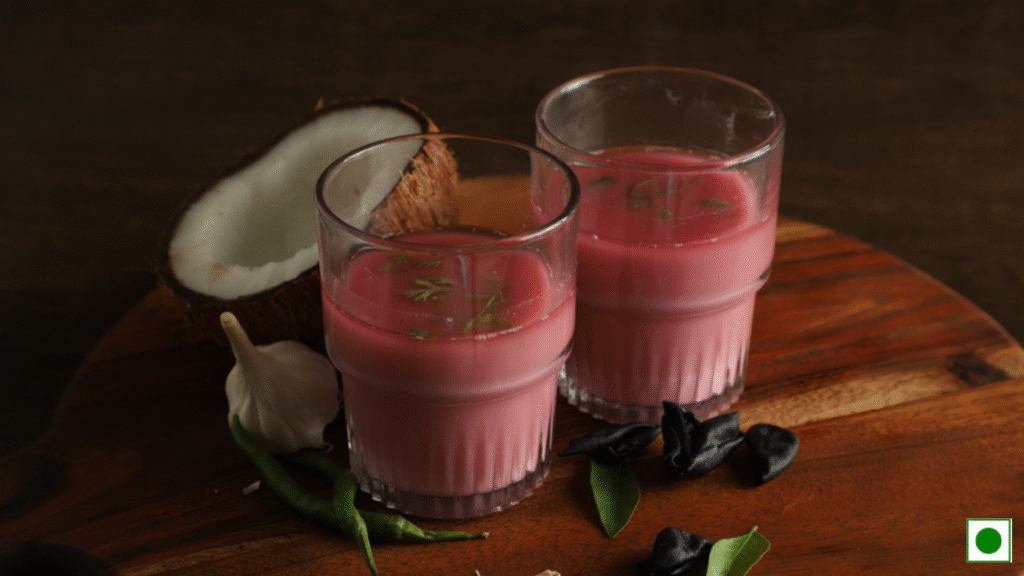
2. Bharli Vangi (Stuffed Brinjals)
Baby brinjals are slit and stuffed with a roasted mix of coconut, sesame seeds, groundnuts, and goda masala. They’re then slow-cooked in coconut oil till soft and aromatic.
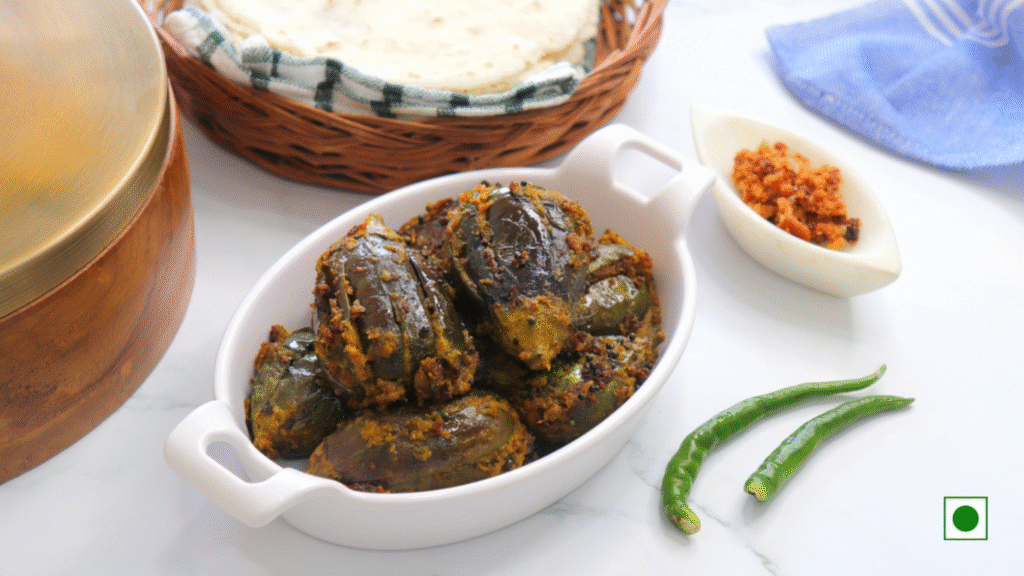
3. Kelphoolachi Bhaji (Banana Flower Stir-fry)
Banana flowers are chopped and cooked with grated coconut and light spices. A slightly bitter but nutrient-rich dish often served with rice.

4. Alu Vadi (Patra)
Made from colocasia (arbi) leaves layered with spicy gram flour paste, then steamed and shallow fried. These crispy rolls are savory, tangy, and perfect with chai.
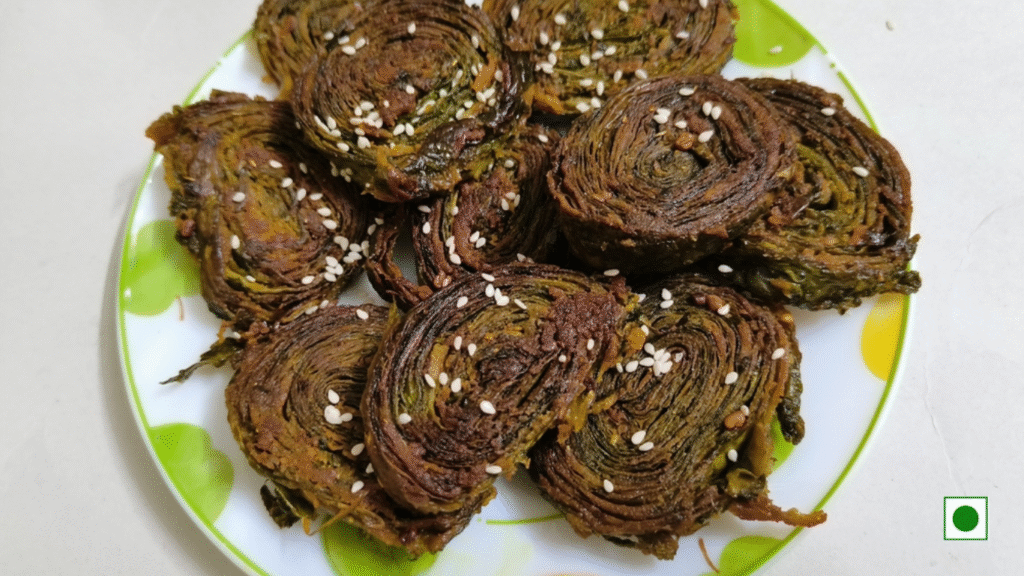
5. Phansachi Bhaji (Raw Jackfruit Curry)
Raw jackfruit chunks are cooked with coconut, chili, turmeric, and jaggery. The texture mimics meat, making it a popular veg dish during festivals and fasting days.
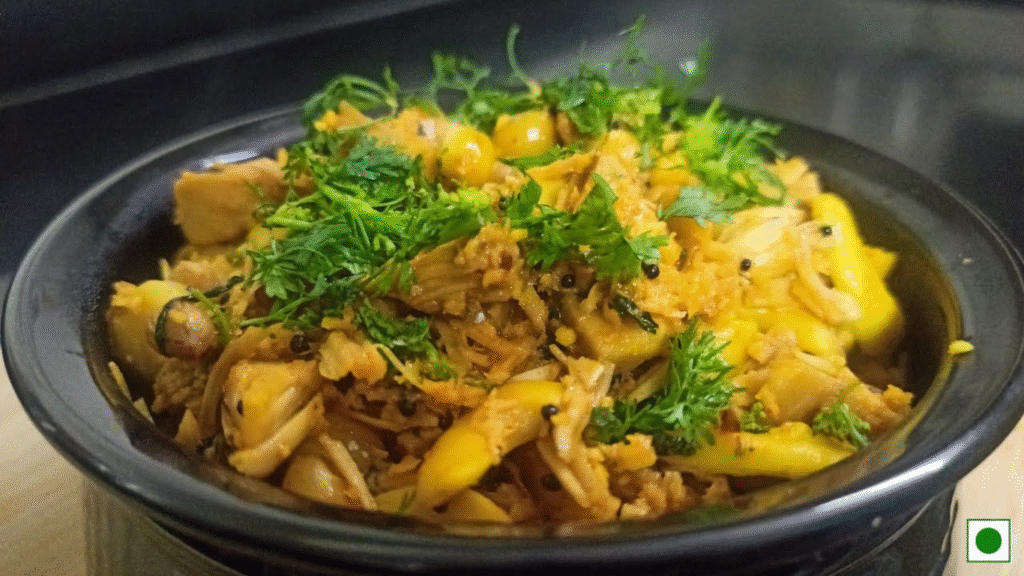
6. Amboli: The Konkan Pancake
A fermented rice and urad dal pancake — soft, sour, and spongy. Served with chutneys or vegetable curries. It’s a Konkani version of dosa, often eaten for breakfast or lunch.
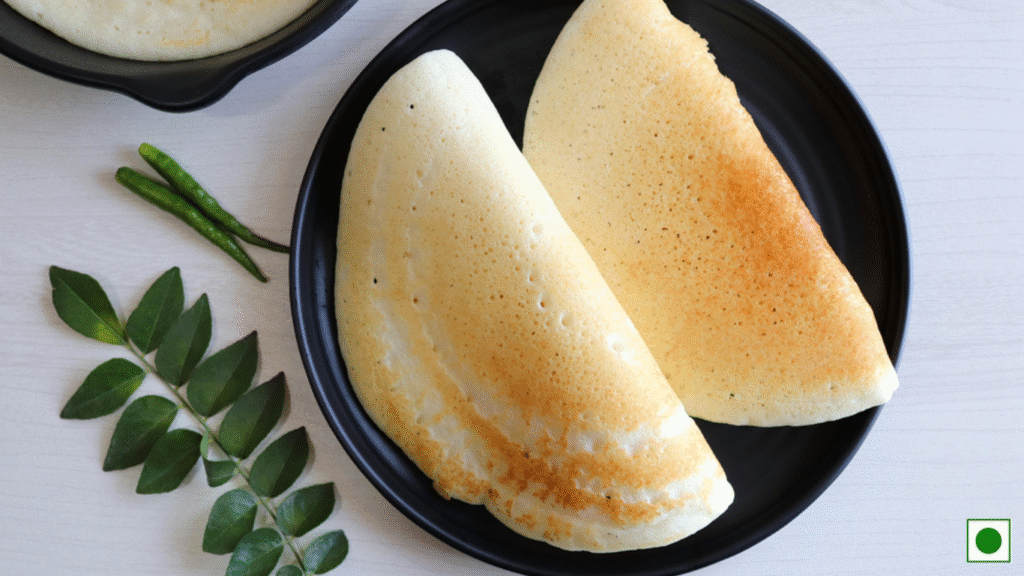
7. Khatkhate
A wholesome mixed vegetable stew made with seasonal veggies, coconut, tamarind, and jaggery. A signature dish in Saraswat Brahmin homes, especially during religious events.

8. Vaalachi Khichdi (Field Bean Khichdi)
Rice cooked with sprouted vaal (field beans), tempered with mustard seeds, curry leaves, and coconut. Protein-rich and light on the stomach.

9. Tandalachi Bhakri (Rice Flour Roti)
Soft, slightly chewy flatbreads made from rice flour. A staple in Konkani homes, usually paired with vegetable curries or chutney.

10. Ukadiche Modak: The Tasty Sweet Treat
The star of Ganesh Chaturthi — steamed dumplings filled with jaggery, coconut, and cardamom. While it’s a festive sweet, many Konkan households make it year-round.
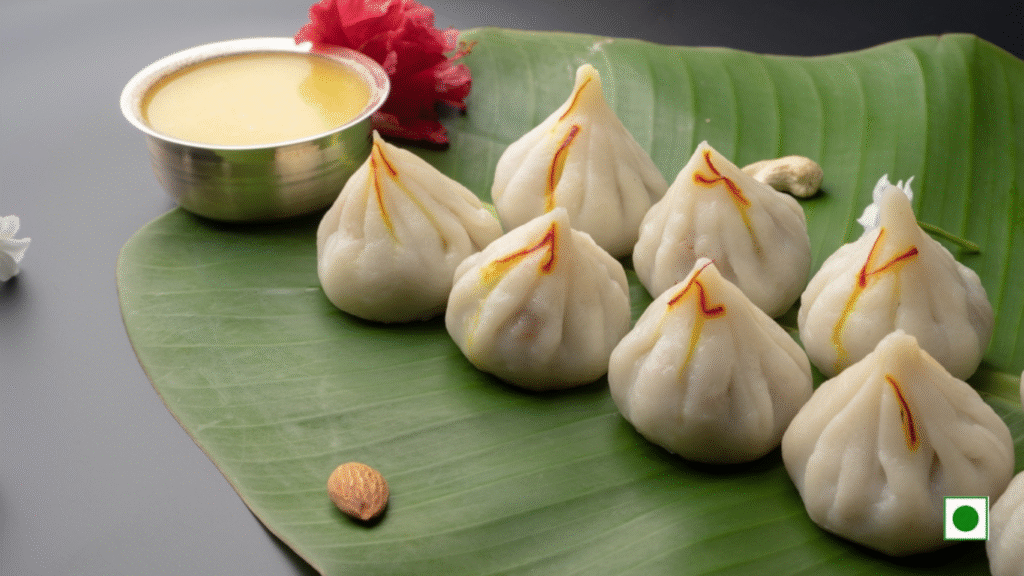
11. Olya Kajuchi Bhaji (Raw Cashew)
Konkani Kaju Bhaji is a rich and creamy curry made with raw cashews, a staple ingredient in the coastal cuisine of Konkan. It’s a popular dish enjoyed for its rich, nutty flavor and smooth texture.
The combination of coconut and spices creates a deep, flavorful base.

12. Shiravle
Rice flour is cooked in the boiling water and the dough is kneeded. Then they make it into the noodle shape, steam it and eat with cold coconut soup.
The combination of the soft, chewy noodles with the rich, sweet coconut milk sauce creates a delightful taste experience. Shiravle is often prepared for festive occasions and family gatherings, making it a cherished part of Kokan culinary heritage.

13. Narali Bhat
Narali Bhat or Naralacha Bhat is a traditional Maharashtrian sweet rice made using fresh coconut pulp, jaggery, ghee and dry fruits. Narali Bhat is the customary preparation prepared on the occasion of Narali Poornima which falls in the month of Shravan in the western coastal belt of India in Maharashtra.
Made with freshly grounded Coconuts that are sweetened with Jaggery and cooked with aromatic and flavorful rice, this preparation is simple and yet exquisite.

14. Rushi Panchami Bhaji
This is one of those must dishes that are prepared during Rishi Panchami, that is celebrated in Konkan on the second day of the Ganesh Chaturthi festival. It is one of those veggie preparations that is not just delicious, but super healthy, vegan and gluten-free too.
A unique thing about this dish is that it includes all those veggies, leafy greens, and tubers that are farmed without the use of an oxen. The most authentic Rushichi Bhaji is cooked in earthen pots, where each vegetable is cooked separately as the cooking time differs.
The list of veggies included is quite extensive. But it is because of this seasonal bounty by Mother Nature, that this classic bhaji is a fantastic creation. It’s like, being really blessed by the Supreme powers!

15. Tandalache Vade (Rice Puri)
These unique puris are traditionally made of rice flour and sometimes with a mix of various lentil and cereal flours.
The crisp outer texture and the soft inner texture makes the Rice Vada a perfect bread for any coconut-based curry or vegetable dish, sprouts or legumes curry or Kala Vatana Usal accompanied with onions, lemon slices or a pickle and a serving of the refreshing Solkadhi.
Non-Vegetarian options also include pairing these with Chicken or Fish curry.

16. Kokum Juice
Kokum Juice, a refreshing and rejuvenating summer cold drink is an essential part of Konkani household. A super coolant, try this Kokum Juice for all things refreshing and rejuvenating for the body.
Kokum or Garcinia Indica flourishing in the Western Ghats of India is also known as ‘Vrikshamla’ in Ayurveda. It is considered as one of the most cooling fruits rich in antioxidants, flavonoids and other nutrients. It is best for digestion and is healthy, especially drunk in the events of Pitta.

17. Kulith Pithla (Horsegram Curry)
Kulith Pithla – a flavourful dish made from horsegram (kulith) flour. This is also known as Pithi in Konkan. Kulith Pithla is Konkan’s answer to Indian superfood.
It is a thick curry made using gram flour and spices and is generally served with rice, bhakri & Mirchi thecha.

18. Bhoplyache Gharge (Pumpkin Puri)
Bhoplyache Gharge is a typical deep-fried Maharashtrian snack made using grated red pumpkin, jaggery and wheat / rice flour.
Bhoplyache Gharge are delicious on their own but you can also have them with some Mango or Lemon pickle or sweet Kheer.
This sweet fried Poori has a great significance during the Ganesh festival in Konkan.

19. Valache Birde
Vaalache Birde is a popular Konkani preparation. Any single festival meal is not completed without this classic dish. Valache Birde is a simple flavourful coconut-based curry. This curry is the most important part of Naivedyam Thali. The chief ingredient involved in this preparation is sprouted dry lima bean also known as Kadve Vaal.

20. Kokum Kadhi
Like Solkadhi, Kokam Kadhi or Kokum Saar (as is popularly known locally) – has two main ingredients – Kokum and fresh Coconut milk! A yard of a typical Konkani home is decorated with lines of coconut and Kokum trees.
While the kokum fruits taste sweet and acidic, the dried rinds are very sour and metallic in taste. These dried rinds are used as an ingredient in recipe of this Kokam Saar!
Kokum Kadhi can be perfectly paired with Bhat (Rice) and Valache Birde
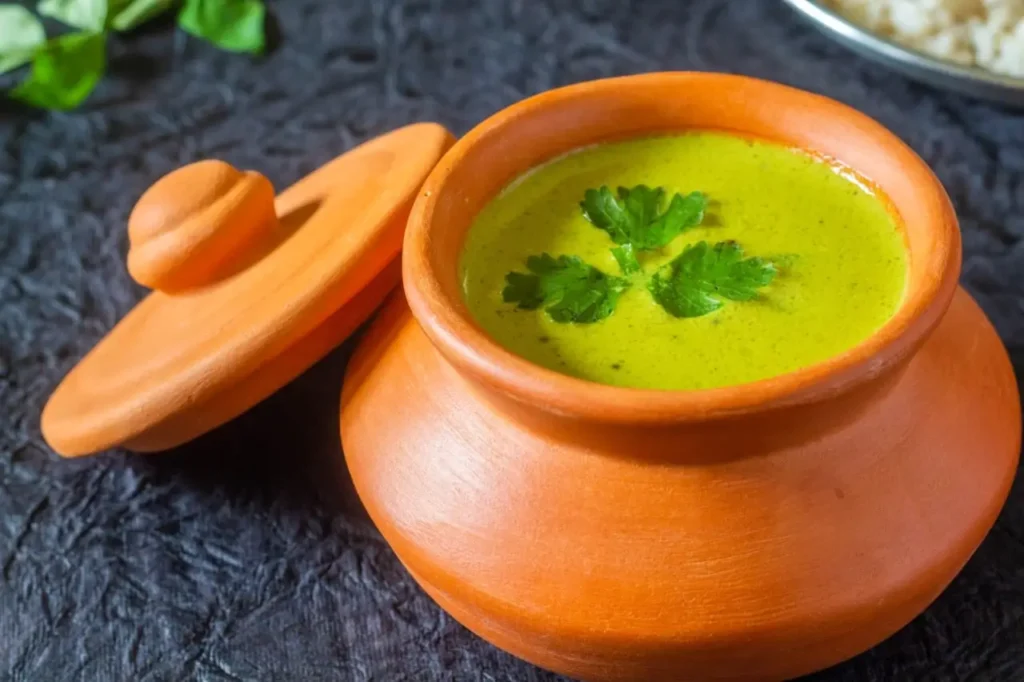
21. Aluchi Bhaji
Aluchi bhaji is a traditional Maharashtrian dish made with taro/colocasia leaves or arbi ke patte. Commonly called Aluchi Bhaji, it is less well-known perhaps outside Maharashtra than Alu Vadi, the other famous dish made with colocasia leaves. However, this mellow, tangy curry is a must-have on traditional social gatherings & festivals in Konkan that pairs well with Bhakri or Rice.
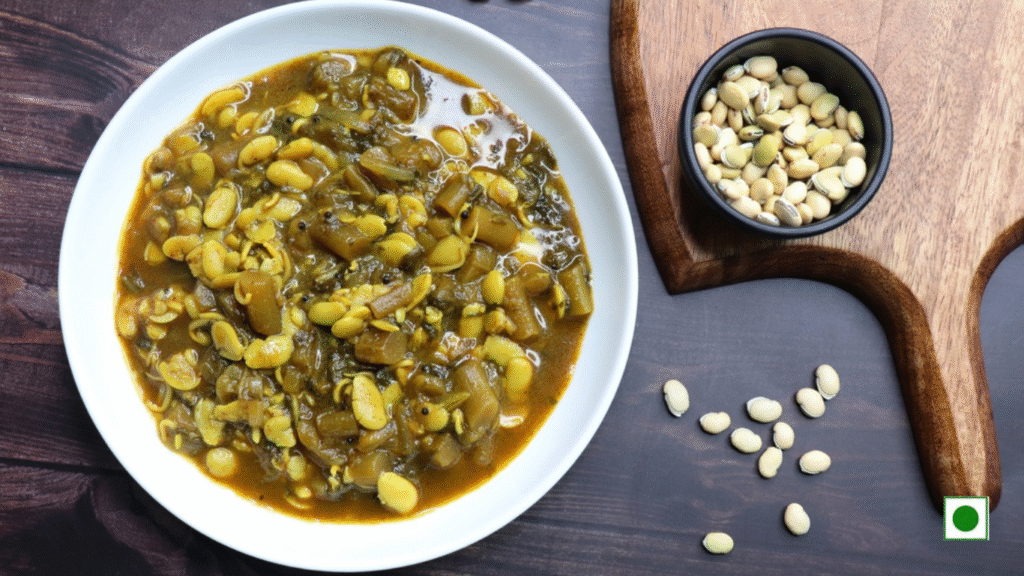
22. Ghavan: The Versatile Rice Crepe
Ghavan (also spelt as Ghavane) – this rice crepe has become an integral part of daily diets in Ratnagiri & Sindhudurg districts within the Konkan area. The only ingredients needed are water and rice flour hence making this process quick, simple as well and versatile. It can also be eaten with jaggery mixed with coconut or chicken/ fish curry. Would therefore go well if one wants a light meal or breakfast since it has less weight due to its aerated nature.
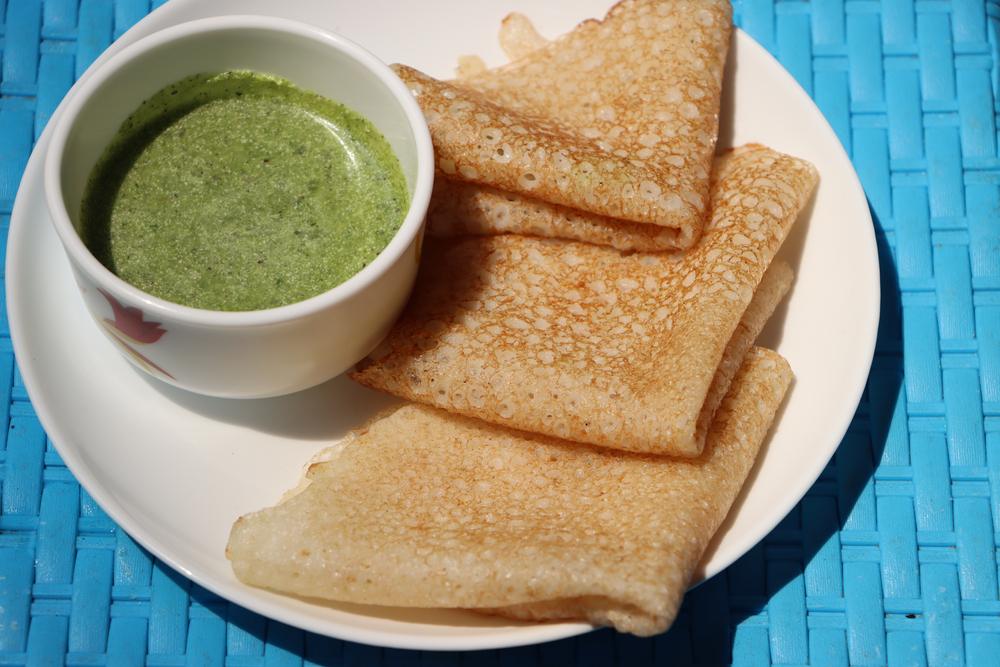
23. Patholi
Patholi or Patoli is a sweet dish mostly prepared on the Konkan region during Gowri Pooja, Ganesh Chaturthi and Naga Panchami festivals. Patholi is made of rice, grated coconut and jaggery which are steamed in turmeric leaves. The turmeric leaves add their heavenly fragrance and flavour to these rice dumplings. The sweet, inner coconut filling makes these rice dumplings absolutely delicious. Patholi are usually served as dessert during meals.
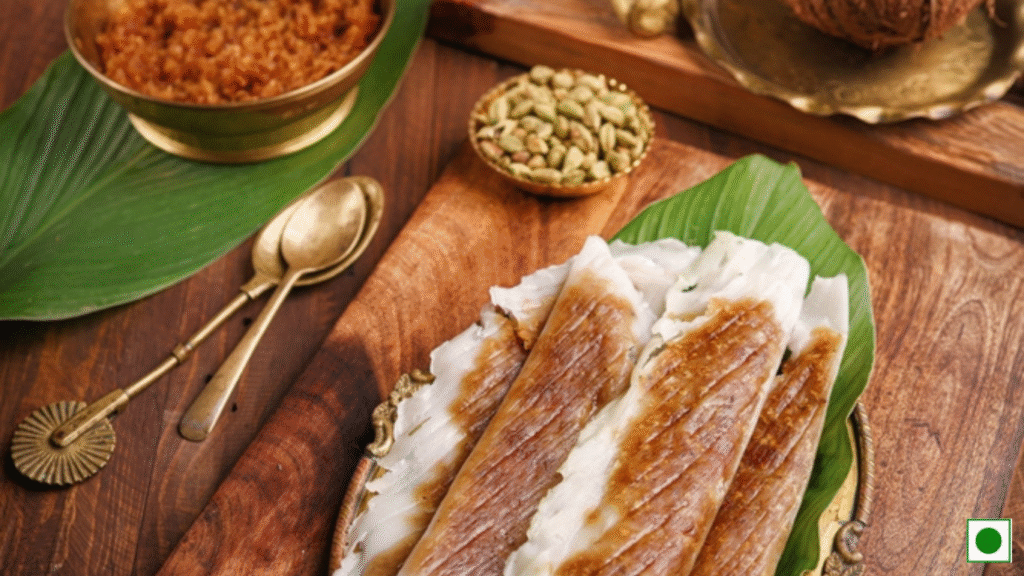
🍂 Seasonal Specialties
Konkan’s vegetarian dishes are deeply tied to its climate and seasons:
- Monsoon (June–Sept): Alu Vadi, Amboli, Khatkhate
- Summer (March–May): Raw mango chutneys, Sol Kadhi, Jackfruit curry
- Festivals: Ukadiche Modak, Patholi (steamed rice flour crepes), Dhondas (sweet cucumber cake)
🏡 Cultural Significance
In many Konkani homes — especially among Chitpavan, Saraswat Brahmins, and local farming families — vegetarian food is more than a dietary choice; it’s tied to:
- Religious observance: Many communities follow vegetarianism during festivals or specific days of the week.
- Sustainability: Dishes are made with local produce, often grown in backyards or family farms.
- Tradition: Recipes are passed down generations and often cooked in traditional clay or brass utensils over wood fires.
📍 Where to Try Vegetarian Food in Konkan
- Local Homestays: The best way to experience authentic veg food is in homestays — freshly prepared by locals using ingredients from their own farms.
- Village Eateries (Khanavals): Especially in Ratnagiri, Devgad, Dapoli, and Chiplun — ask for a “vegetarian thali”.
- Festivals: Visit during Ganesh Chaturthi or Holi to taste homemade sweets and seasonal dishes.
🙋♀️ FAQs
Q: Is it easy to find vegetarian food while traveling in Konkan?
Yes! While the region is known for seafood, vegetarian thalis are widely available and deeply rooted in local culture.
Q: Is the food too spicy?
Not typically. Most vegetarian dishes are mild to medium spicy, balanced with coconut and jaggery.
Q: Can I learn to cook these dishes?
Absolutely! Many homestays and cooking classes in Konkan offer short tutorials for tourists.
🧳 Final Thoughts
Konkan’s vegetarian cuisine is a hidden gem that reflects the region’s simplicity, sustainability, and soul. Whether you’re sipping Sol Kadhi under a coconut tree or enjoying a plate of Alu Vadi with rice, you’ll taste a piece of Konkan’s heritage in every bite.
Next time you plan a trip or want to try something new in your kitchen — Go Konkani, and Go Veg!


